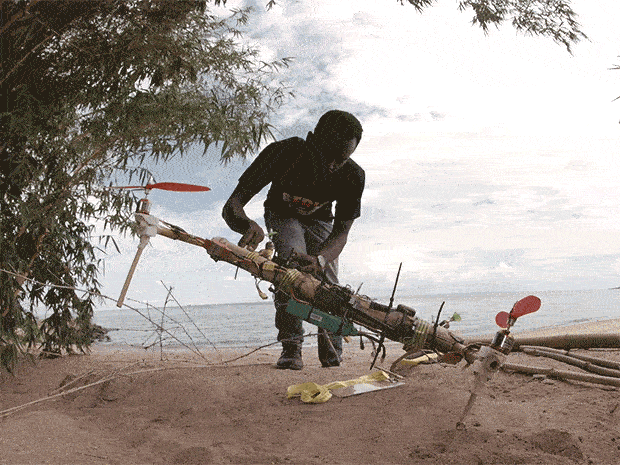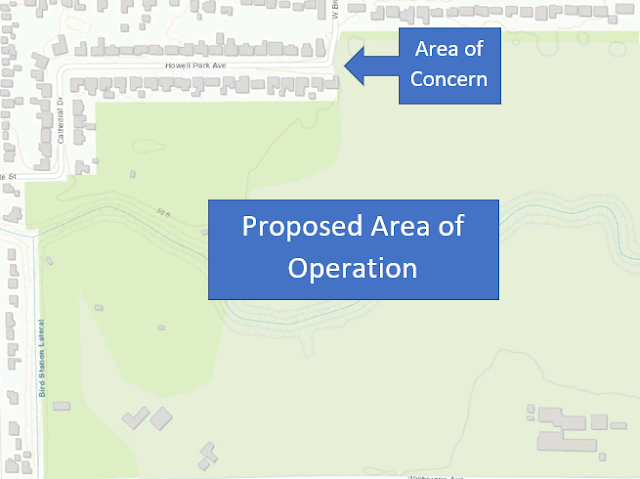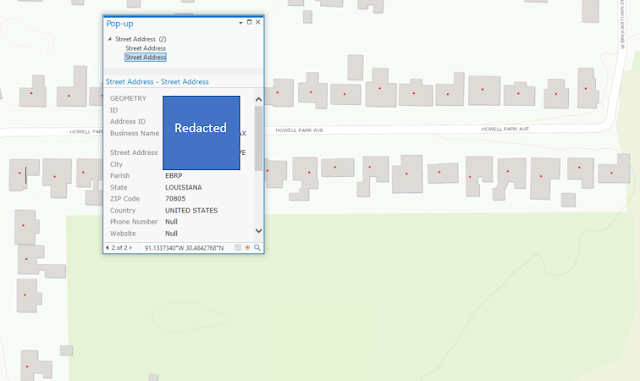A continuously updated website highlighting my experiences of UAS, the data, and the deliverables Unmanned Aerial Vehicles (UAVs) can provide.
Monday, January 2, 2023
How Enterprise UAS Offer Value to Civil Engineering Projects
Friday, December 23, 2022
Happy Holidays From USI
See Alan Cry and Then Have to Get Back to Work
Oh boy, looks like the marketing team decided to spice things up for the holidays! Instead of the usual holiday stuff, they came up with a brilliant idea: have our brave colleagues taste some fiery hot sauce and film their hilarious reactions!I was one of the unfortunate souls who took on this hot challenge. Let me tell you, I felt like i was conbusting in the inside! I mean, I can barely handle a flaming hot Cheeto, let alone a sauce with the following stats:
Wednesday, November 16, 2022
Can UAS Themal Data Add Value to Bridge Inspections?
Overview
Many know that thermal equipped UAS are useful for infrastructure inspections, but few know how they add value compared to traditional inspection methods. In the case of concrete deck inspections, thermal equipped UAS can be an extremely valuable tool because the collected data can expose deficiencies often invisible to the naked eye. I am not going to spell out how exactly this translates into cost savings, but the value can be in the tens of millions depending on the structure scanned.
Secret Hints About UAS Thermal Ops
From a deliverable standpoint, the product is a preventative maintenance plan. To get to that point, be prepared for a big investment in a specific thermal camera, take more than one thermography training and have design and structural engineers in your office. If you get that far, make sure your thermal imagery has visual reference imagery, invest heavily in computer software, and make sure you have the aircraft and camera settings dialed in.
Oh yeah, make sure you can legally the area of interest in the first place! At this point, I have provided more than enough hints about how thermal offers value to concrete bridge deck inspections including the document below that I created with USI Consultants. If you have any questions, please reach out to me directly.
Sunday, September 4, 2022
What The XT2 Can Do For You
Overview
Taken from DJI’s Website, the Zenmuse XT2 is a side by side visual and thermal sensor that allows us to pick up thermal energy emitted from a surface. Depicted in Figure 1, this camera is compatible with the DJI Matrice 200 and 300 series and offers a plethora of capabilities including live heat tracking, temperature alarm, isotherm measurements, etc...,
How XT2 Video Offers Value to Inspections
In the case of bridge deck inspections, side by side visual and thermal video can be extremely useful in gathering preliminary data about the condition of a bridge deck. If you click on Figure 2, you will be directed to a YouTube Video I captured which shows the video recorded from the XT2 looking straight down at the bridge deck. Credit to USI Consultants for allowing me to share this video.
Why is Properly Formatted XT2 Video Important?
For the sake of not giving away all our secrets, I will answer this question vaguely. Overall, videos created in this format allow us to see EXPLOIT INVISIBLE DEFFICINCIES quickly. Is this the most perfect accurate way to assess a bridge deck condition, no because there is so much more that can be analyzed from Radiometric JPEGs that can be captured by the XT2. However, for a 10-minute flight, video from the XT2 significantly reduces fieldwork.
Are There Cons to Recordings Taken from the XT2?
Yes, since the XT2 is two cameras in 1 sensor, the frame rate and the frame sizes need to be scaled and trimmed with fairly expensive video editing software. This limitation can be addressed with a solid QC/QA program and thermography training. Thermography training is also vital to the mission planning and further data analysis which can be done with additional UAS software that I will not go into detail in this post.
Conclusion
Knowing how to use the XT2 and the thermography software needed to edit and, understand and in some cases interpret deficiencies is vital to successful bridge deck inspections. If you have any questions about our workflow we would be happy to share with you more information. Please reach out to USI Consultants by clicking on Figure 3 below.
Tuesday, May 10, 2022
UAS and Stormwater Applications
Overview
Local, state, and federal agencies have utilized UAS for items such as stormwater management, environmental compliance, and safety inspections. From a general documentation perspective, UAS is a tool that can provide reliable and repeatable observations which (when processed correctly) can easily show changes of subjects over time. Rather than list the multitude of applications UAS offers to stormwater asset management, the following YouTube video does a good pretty job highlighting practical value derived from UAS services. Note: the first 20 minutes are useful, the last 20 minutes are not related to stormwater.
Bonus Content
Below is a flyer I created demonstrating how using photogrammetric mapping can allow end users to monitor stormwater assets that are new, missing, or yet to be geotagged. In the case of deveopling communities, areas with heavy construction, or areas impacted by natural disasters, you would be suprised to learn how many stormwater assets become "rediscovered" from UAS imagery alone. Using engineering and GIS software, a high resolution georeferenced digitized map delivered from UAS becomes vital to future planning and deveoplement because it greatly reduces site visits, misjudgement and ambiguity.Tuesday, December 14, 2021
Calculate Assets Rapidly With sUAS Technology
Overview
By creating a workflow involving strategic mission planning, fairly sophisticated UAS remote sensors, photogrammetric software, and data analysists, we have the ability to provide estimates for the total volume of an asset (or multiple assets) significantly quicker than traditional methods. To be blunt about this subject, many UAS people with photogrammetry software can estimate a volume with various degrees of confidence, but at USI we have a QC/QA program that can provide more confidence in our findings to ensure the information we provide is specific to the unique parameters of the mission and each invividual client expectations. Linked below is a PDF that showcases some of the projects I have flown and the services we offer at USI Consultants.
Thursday, May 28, 2020
Creating Animations to Visualize Changes in Assets
Overview Approximately my 2nd Commercial UAS flight working at USI Consultants, I was tasked with flying a photogrammetry mission to compare changes in earthwork for a project located in Hamilton County Indiana. Since employees were nice to me being the “new guy”, I used a previous successful mission as a template and tweaked some of the settings to fine tune the specific parameters of the mission I was tasked with flying.
Unique Mission Variables During this time, Covid-19 was at its peak, and it was significantly more contagious because there were no vaccinations to prevent the spread. Nevertheless, we wanted to show the client the changes from our touchless assessments as well as deliver them a quantity for the earthwork they moved.
Opportunity to Showcase Video Animations Video animations have their place for marketing purposes but are typically not worth the time making for engineering projects. However, in this case, we had four elements that made this project unique.
- A previous flight with that captured the same subject
- The ability to use animation trajectories from photogrammetry software
- The need to visualize a change
- The need to provide a quantity
As a result, I created a side by side video animation that could be shared with everyone needed to see the site changes which ultimately saved time, lowered cost, and in this case eliminated the need for unnecessary exposure to Covid….One might argue that Covid exposure is low when being outside since this was an outdoor project, but imagine if a crew had to stop to get gas on the way to the site or needed to take 5 additional vehicles….could the exposure risk be exposed? Would the travel cost be reasonable still? Below is the link to the animation with the mentioned elements.
Wednesday, November 20, 2019
Trip To Tanzania
A few months ago, I was selected to by a sustainable volunteer program to travel to Tanzania Africa this December. In preparation for the trip, I have been learning about the culture, the laws, and the travel requirements that I will have to adhere to during my adventure. Since I am a UAS student, I am particularly interested in how Tanzania is using UAVs to serve it’s people. Therefore, this post is about Tanzania’s UAS applications.
Table of Contents
Part 1---------------------------------------------------------------------------------------------------Fighting Malaria with UAS
Part 2--------------------------------------------------------------------------------------------------Delivering Blood with UAS
Part 3------------------------------------------------------------------------------------------Intercepting Poachers with UAS
Part 4----------------------------------------------------------Utilizing Local Resources to Construct a UAV Airframe
Part 5-------------------------------------------------------------------------------------------------------Tanzania Aviation Law
Part 6-----------------------------------------------------------------------------------------------------------------------Conclusion
Fighting Malaria with UAS
Depicted in Figure 2 is a DJI Agras MG1-S spray UAV in Cheju, Tanzania. Taken from an article in Forbes Magazine, this specialized platform is designed to fight malaria which is responsible for killing 80,000 people per year. according to malariaspot.org. As being considered one of the first UAS based biological control applications in the world, could a UAS with operating limitations make a faster more cost-effective spray then manual spraying efforts? For more information, click on the figure to be directed to the article.
Sounding more like a vampire program than a UAS program, a UAS collaboration consisting of Wingcopter, DHL, and the Deutache Gesellschaft fur Internationale Zusammenarbit (GIZ) have utilized a vertical take off and landing platforms (VTOL) to deliver blood and medical supplies to difficult to reach areas in Tanzania. Similar to efforts taken by Zipline, this method of UAS operation can help doctors save lives because instead of taking 4 hours to transport medical supplies, a Wingcopter can make the delivery in 20 minutes. To learn more, click on Figure 3 and you will be directed to their promotional video. Within it, notice how the doctors appear to be holding a transmitter upon landing of the aircraft. Why do you think they are doing that?
Taken from Drone blog.com, Tanzania has an anti-poaching initiative that involves flying UAVs over national parks, reserves and other protected areas to help security track and intercept poachers. Depicted in Figure 5 is Super Bat Da 50 UAS in front of the UAS crew and security personal. A product by Bathawk Recon this system can not only stay in the air for 8 hours, but it has several sensors that claim to be able to easily track poachers before they arrive to the animal heards. Could this be an effective tool to combat poaching? Or is this another example of overrated technology taking advantage of Africa?
 |
| Figure 3: Superbat Da 50UAS |
Taken from spectrum.com, Figure's 4 and 5 depicts Bornlove Ntikha using bamboo for the frame of his DIY UAV. Ntikha wants to show that UAVs can be built out of locally available materials which can help others learn how to construct UAVs themselves. Although this technology still requires a motherboard, a transmitter, batteries, and motor components, it is remarkable to see this take flight. If a sensor can be integrated to this platform and the UAV can be programmed to fly autonomously, nobody will care about the type of airframe as long as the UAS can perform missions safely and produce deliverables. Could this method of constructing UAVs be applied to more local Tanzanian UAS projects?
 |
| Figure 4: Bornlove Ntikha Working on a DIY UAV Using Local Resources |
I am not an expert on Tanzania’s aviation law, nor am I an expert on how to interpret it, however if you are curious to see what UAS policy’s I have created a bullet list of Tanzania’s UAS laws that I could find online. In other words when regarding flying in Tanzania, you should consider the following:
- UAVs weighing Unser 15.5 lbs do not require a permit to fly
- UAVs weighing over 15.5 lbs require a special permit from the Ministry of Defense
- UAVs require insurance no matter recreational or commercial operation
- Class 1: 0-11lbs
- Class 2: 11 – 55lbs
- Class 3: 55 lbs and more
- Category 1: leisure and sport
- Category 2: private use except leisure and sport
- Category 3: commercial use
- https://static1.squarespace.com/static/59311e48bf629a7d92b39065/t/5a574bca53450ad102603b6e/1515670486660/AIC+05+-+2017+Unmanned+Aircraft+Systems.pdf
- https://www.tripadvisor.com/ShowTopic-g293747-i9226-k10180983-Use_of_drones_in_Tanzania_not_in_NPs-Tanzania.html
- https://uavcoach.com/drone-laws-in-tanzania/
- https://africandrone.org/tanzania
Although it each UAS application in Tanzania is powerful, interesting, and can hopefully benefit the greater good, I favor Nikha’s story the most because he is an example of Tanzania’s self sufficiency as it will hopefully be able to one day create UAS technology rather than contract out to other countries. Nevertheless, each article as well as the Tanzanian government’s efforts to regulate the UAS operations within the country demonstrate that UAS has the potential to grow in Tanzania.

Thursday, November 7, 2019
GIS Day Results
As mentioned in previous posts, Purdue’s 11th annual GIS Day took place at Purdue’s Stewart Center on Thursday November 7th and featured a variety or subject matter experts from local, state, and federal companies. For roughly eight hours, I spent my time either presenting, questioning, or listening to a variety of people talk about their backgrounds in GIS and noted what deliverables they have been able to produce as well as learning why their deliverables were considered cost effective.To help further promote the UAS presence in GIS applications, I volunteered to present in front of an audience as well as enter a poster competition. Despite being my first-time attending GIS day, as well as being the only independent researcher, I earned second place in the Poster competition as shown inn Figure 1.
 |
| Figure 1: Myself (Right) Earning 2nd Place for Purdue's GIS Day Poster Presentation |
The material that I learned from this conference ranges from using GIS to survey census data to using GIS as a tool to survey erosion. In an effort to keep this content UAS related, I felt particularly interested in a presentation by Dr. Carly Sakamura from Maxar Technologies. Although this blog post fails to describe the amount of information in her presentation, she provided a unique perspective of showcasing the interest of the satellite data, and the challenges that the Maxar experiences when mapping the planet.
Although Unmanned Aerial Systems differ greatly from satellites, I was able to relate to her emphasis on the importance of collecting and interpreting accurate data let alone the data collection storage challenges that Maxar had to address. From a privacy standpoint, I found it fascinating that although satellite imagery cannot expose more than 30-centimeter accuracy, it is not because the technology cannot rather it is because the government “will not allow it”. This leads me to reflect and believe that below 30-centimeter accuracy satellite data exists, but not for the general public.
Without harping on the above statement too much, I wonder how UAS mapping will accommodate national security interests, let alone who will be able to legally obtain highly accurate UAS data given the fact that UAS data a has potential to redefine the way we see the world. Will accurate UAS data produce the same challenges that below 30 meter satellite accuracy does? Or will the technology one day enable people to inexpensively purchase a UAV that can compete with satellite data?
Critiques and Conclusion
From a career development standpoint, I will be sure to go out of my way to participate in further GIS Day Conferences. Although my overall GIS day experience at Purdue was extremely meaningful, I hope that I can participate in future GIS day conferences where sensor specific subjects are discussed more openly. Due to the fact that I currently work with a variety of different sensors with a plethora of different applications, I think that learning about the sensors used to collect data can greatly improve my lexicon of factors to consider while planning UAS missions.
Furthermore, I hope to make it a priority to explore more open sourced software because not only is it free, open sourced software can provide solutions to problems that could otherwise cost thousands of dollars in licensing. Taken learn.g2.com, clicking on Figure 2 is a lexicon of 10 free different open source websites to consider. It looks like I will be starting there…
 |
| Figure 2: Access to learn2.com |
Wednesday, October 30, 2019
Where Are My Pants?
 |
| Figure 1: Can you Find the Jeans in This Image?
Although manually filtering through images was time consuming, and the jeans are difficult to see, this proof of concept depicts that UAV software could be invented to quickly locate objects from pixel clusters. Or.... maybe software like this already exits? Nevertheless, I thought it was incredibly interesting learning about UAS related search and rescue applications, and as much as I wish I was allowed to talk about it more, I will gladly refer you to Loc8's website for further exploration.
|
 |
| Figure 2: Location of Jeans After Manual Search |
Sunday, October 20, 2019
Capstone Assignment 7: Products Methods and Updates for GIS Day
Table of Contents
Scenario 4----------------------------------------------------------------Estimating Line of Sight to Keep Eyes on the UAV
Scenario 5-----------------------------------------------------------------------------Applying GIS Software to UAS Software
















